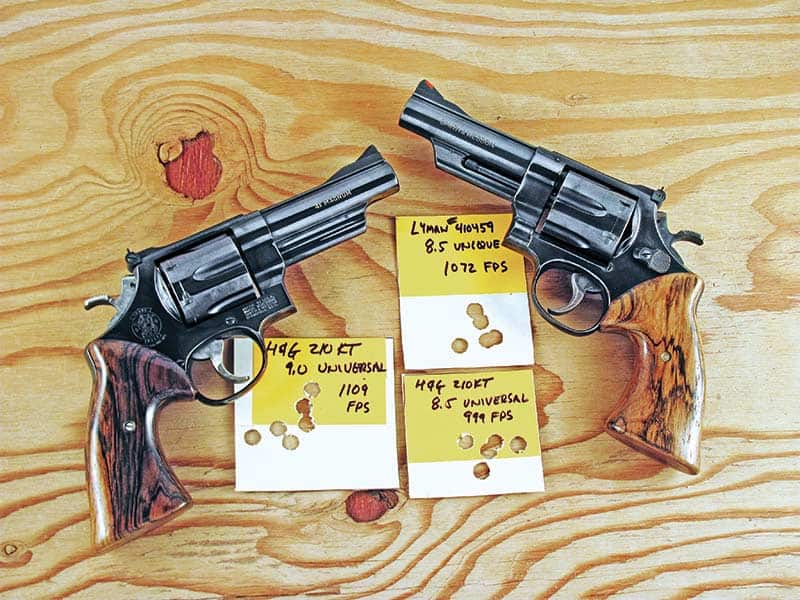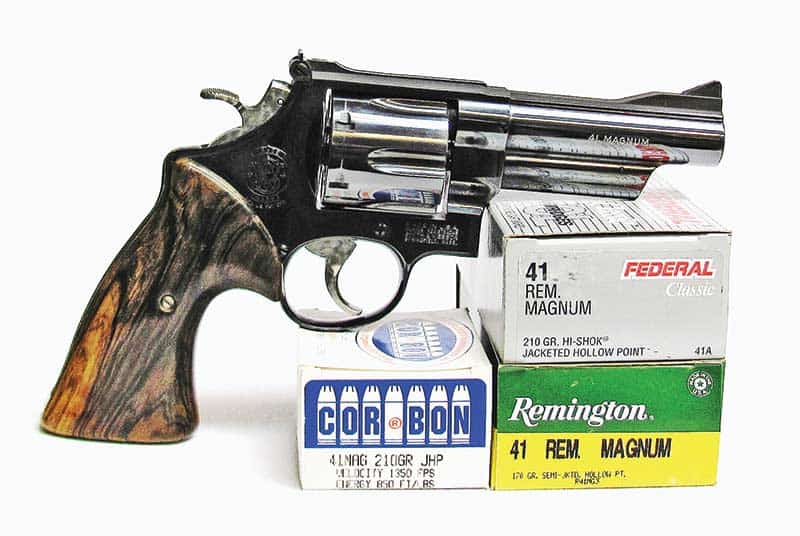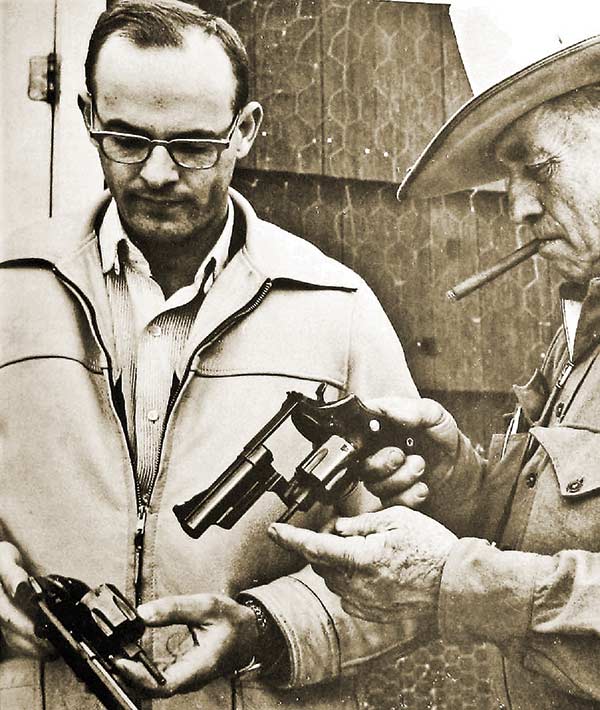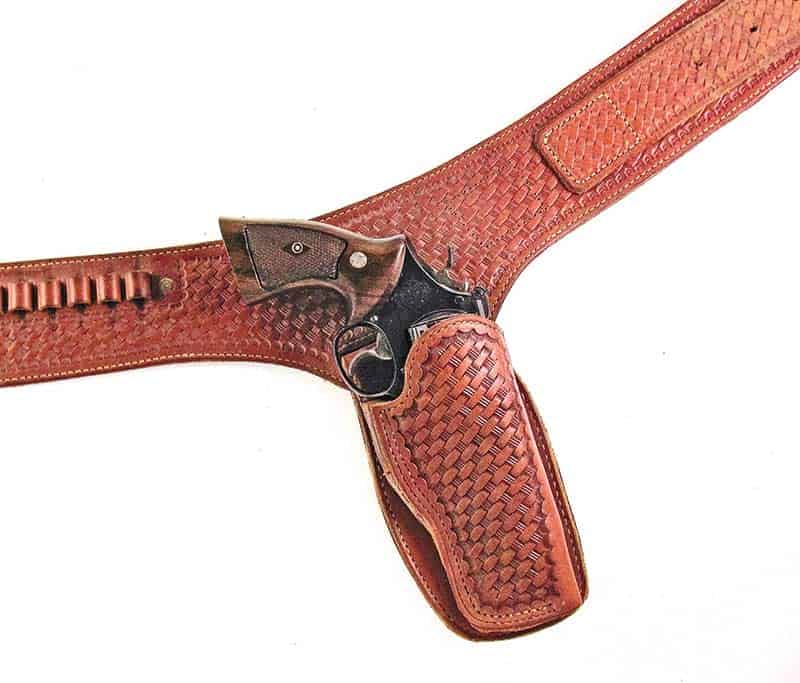Perfect Packin’ Pistol Part VII
The .41 Magnum
We continue our look at the Personification of the Perfect Packin’ Pistol using these words from the Taffin Dictionary of Sixgunning: “Perfect Packin’ Pistol is a title given to a sixgun or semi-auto with a barrel not less than 4″ nor more than 5-1/2″ which can be carried easily all day in a well-designed holster, placed under a bed roll comfortably at night, and can be expected to handle any situation which should arise.”
The seventh and last cartridge to be looked at from S&W, chambered in a swing-out cylinder double-action revolver, is the .41 Magnum. This was the last practical magnum cartridge for chambering in a Perfect Packin’ Pistol. S&W would come up with two more magnums, the .500 and the .460; however both of these cartridges require extra large frames — in fact Smith & Wesson calls them X-frames. They are too large to be carried comfortably on a daily basis.
In 1968 I had a brand-new Ford F250 V-8 four-on-the-floor PU with a camper shell. I loaded our three pre-school kids in the truck and I set out on a 2,500 mile adventure to take them back to visit their two sets of grandparents for the summer. Diamond Dot and I took the opportunity we had — with the kids gone — to spend some time camping. We loaded the pick-up with groceries, sleeping bags, an assortment of sixguns and headed out with no particular destination in mind except one. We would stop in Salmon, Idaho and visit Elmer Keith. We spent a day with him and his wife and that evening he turned on the news and said to me about CBS, it was the “Communist Broadcasting System.” What would he say today?
Elmer’s .41?
Elmer was well known for packing a 4″ .44 Special until 1956 when he changed to a 4″ .44 Magnum. However, I found him carrying something else. It still had a 4″ barrel and still had carved ivory stocks and was still carried in his favorite holster, except this time the chambering was .41 Magnum, another cartridge he had a lot to do with being introduced. I just happened to take along my 4″ .44 Magnum, with the belt and holster I had designed and fabricated myself. He made me feel awfully good when he said how much he liked my design and how just about everything was right with it. I still have that rig, however the belt has mysteriously shrunk over the passing of 50+ years.
S&W was the first company to market a .41 Magnum sixgun. In his book, History of Smith & Wesson, Roy Jinks says of the .41 Magnum: “The .41 Magnum was developed in 1963 to fire a cartridge between the .357 Magnum and .44 Magnum. When the cartridge was developed, Smith & Wesson manufactured a companion revolver to its famous Model 29. It was identical to the Model 29, except that it chambered the .41 Magnum caliber.”
From the very beginning the Model 57 (.41 Magnum) was available in both blue or nickel and also with a 4″ barrel. The Model 57 is a popular handgun with connoisseurs of the cartridge; however it has never had the following of the .44 Magnum. Not even close! It was a cartridge needed to fill a gap, but for some unknown reason, this model never received the recognition it deserves.
In addition to the beautifully finished and adjustable-sighted Model 57, S&W also came up with the fixed sight Model 58 .41 Military and Police. The first test gun in this caliber was built on the frame of a .38/44 Heavy Duty revolver; however the production gun did not have the desired enclosed ejector rod of the Heavy Duty. The Model 58 was developed primarily for law-enforcement use; therefore, when it was introduced, it was only manufactured with a 4″ barrel having either a blue or nickel finish. Had it been offered with the enclosed ejector rod I think it would have been much more popular with outdoorsmen.
In his autobiography Hell, I Was There, Elmer Keith shares his part in bringing the .41 Magnum to fruition: “… While we were attending the NRA convention in Washington, D.C., Bill Jordan, the old border patrolman, came to me and says, ‘Elmer, you’ve got the .44 Magnum. How about getting a .41 Magnum for the police and sheriff’s departments over the country that don’t care for the recoil of the big .44?’ I told him, ‘Bill, there never was a better time. All the arms company heads are here as well as ammunition company heads. So if you side with me, we’ll get them all together and get the job done right now.
“I asked them for a .41 Magnum, case length to be the same as the .44 Magnum, bullet diameter to be 0.410″ so that no old .38-40s or .41 Long Colts could ever be revamped to handle the larger bullet as they go around 0.403″. I wanted a 220-grain bullet. Doug Hellstrom also insisted on the 0.410″ diameter to preclude the possibility of a cartridge ever being used in the old .41 guns that would not take its pressure. Earl Larsen of Remington could make the ammunition if the other boys would make the guns. Doug Hellstrom and Bill Gunn of Smith & Wesson agreed to bring out the gun …
Some six months later just as Charlie Shedd and I were leaving for the Arctic on our polar bear hunt, a pair of 4″ Smith & Wesson Magnums, with target sights and triggers trimmed to 3/8″, the hammers cut back about 1/4″, arrived. They had rosewood grips and my name on the side plates of the pair, consecutively numbered, No. 1 and No. 2.”
Historical Facts
Elmer goes on to say he took these brand-new .41 Magnums with him on his polar bear hunt and used the new cartridge on caribou. On his first shot at 100 yards he shot between the base of the horns of a bull caribou causing him to conclude “… the .41 Magnum is a bit flatter in its trajectory than the .44 Magnum I was used to.” I have found the same thing as Elmer in that the .41 Magnum is considerably flatter shooting than the .44 Magnum when shooting both out to 300 yards.
In his book, No Second Place Winner, Bill Jordan shares about the .41 Magnum: “… regarding all the writers who have climbed on the bandwagon and, I am sure, will now make load claims to have been the Pappy or Mammy of this load, I wish to make a statement! I tagged along with Elmer Keith and said ‘amen’ while Elmer cornered the firearms and ammunition people, individually and collectively, at that 1963 NRA members meeting in Washington and got commitments that actually started the ball rolling … So, regardless of who set the actual dimensions and specifications, it was that grand old man of the shooting game who did the work that made this load a reality.”
Bill Jordan, Elmer Keith and Skeeter Skelton all saw the .41 as a better choice for law officers over what was then available. However, it was not to be and very few departments ever adopted it. The standard S&W .41 Magnum would last just under 30 years. In 1986 the stainless steel counterpart of the Model 57, the Model 657 arrived, and before the end of the last century the .41 Magnum would be offered in the Mountain Gun configuration.
It took me a while to adopt the .41 Magnum. Although I came to know the .41 Magnum late, about 15 years after it first arrived, I finally fell for the S&W .41 Magnum and eventually wound up with a pair of 4″ Model 57s stocked with exotic wood. At the time I would’ve said the .41 Magnum with full house loads had less recoil than the .44 Magnum loaded the same. At this stage of my life felt recoil is a real problem and I can’t tell any difference between the two of them. However, I do know both of them are much more controllable and easier shooting with loads in the 900 to 1,000 fps range. And either will handle any situation like any good Perfect Packin’ Pistol should!








